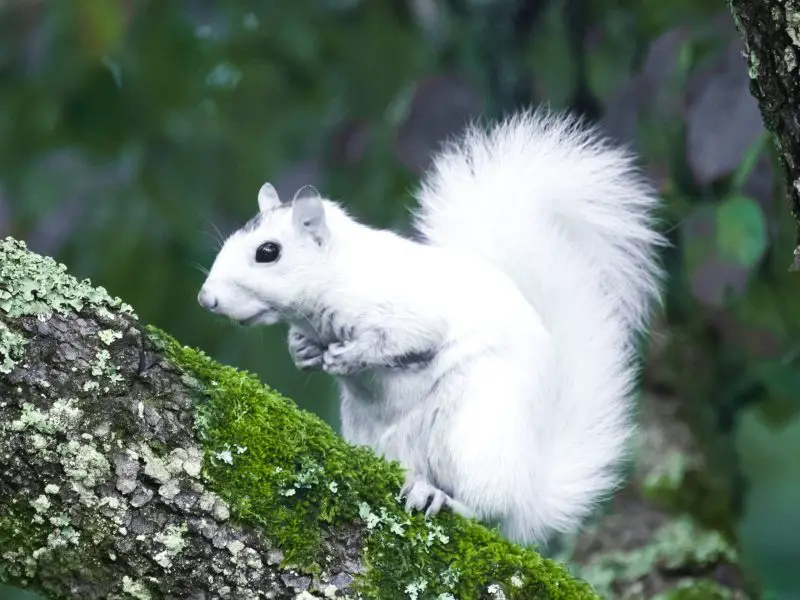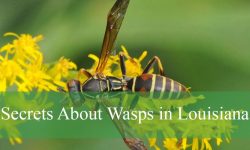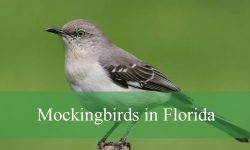White squirrels are among the most captivating and unusual wildlife phenomena in North Carolina. Their striking snowy coats make them stand out against the more common gray and red squirrels, capturing the imagination of both residents and visitors. Known for their rarity, these squirrels have inspired curiosity, local legends, and a devoted following of wildlife enthusiasts.
Particularly in the town of Brevard, North Carolina, white squirrels have become a celebrated symbol of the community. Over the years, they have not only sparked scientific interest but also shaped local culture, with festivals and conservation efforts dedicated to preserving their unique population. These enigmatic creatures offer a rare glimpse into the diversity and wonder of nature in the region.
The Origins of White Squirrels in North Carolina

White squirrels in North Carolina are most commonly associated with a rare genetic condition called leucism, which results in a partial loss of pigmentation. Unlike true albinos, which lack melanin completely and often have red or pink eyes, leucistic squirrels retain normal eye color while sporting a white or cream-colored coat. This mutation is extraordinarily uncommon in wild populations, making North Carolina one of the very few places in the world where concentrations of these animals can be observed with regularity.
Genetic studies suggest that a small founding population carrying the leucistic trait may have established itself in the region decades ago, allowing the trait to persist across generations. Over time, natural selection and the protective measures of the local community have helped sustain this population, making it a rare and fascinating example of how genetics and environment interact.
Historical accounts trace white squirrel sightings in Brevard, North Carolina, back to the mid-20th century. Residents first reported clusters of white squirrels in urban parks, neighborhoods, and wooded areas surrounding the town. Over time, these sightings became more frequent, prompting locals to embrace the squirrels as a defining feature of their community.
Today, white squirrels have evolved into a cultural icon, appearing in town logos, merchandise, and annual festivals. Brevard’s proactive efforts—from preserving tree corridors to promoting public awareness—have allowed the population to thrive, making the town a world-renowned haven for this unique species.
Physical Characteristics and Identification
White squirrels share most anatomical and behavioral traits with gray and red squirrels. They possess sharp claws for climbing, strong hind legs for leaping across branches, and bushy tails that provide balance and insulation. However, their most defining feature remains the white or cream-colored coat, which can vary from pure snowy white to off-white or slightly gray-tinged shades.
Adults typically weigh between 14 and 21 ounces, with a body length ranging from 9 to 12 inches, excluding the tail. Their bushy tails are often as long as their bodies, aiding in balance while navigating treetops and serving as a communication tool.
Despite their similarity in size and anatomy to other tree squirrels, the stark contrast of their white fur makes them highly visible in both natural and urban environments. Observing a white squirrel in its habitat—whether perched on a branch, foraging, or bounding across the ground—offers a surreal and almost magical sight, particularly against the backdrop of green foliage or winter snow.
Habitat and Distribution
White squirrels are concentrated primarily in Brevard, a town nestled in the forests of Transylvania County, North Carolina. The combination of abundant deciduous trees, a mild temperate climate, and plentiful food sources creates ideal conditions for these squirrels to thrive.
Over the decades, the town has cultivated a reputation as a sanctuary, with residents actively protecting natural corridors and minimizing threats from traffic and domestic animals. Their preferred habitats include deciduous forests, suburban neighborhoods, and urban parks that contain nut-bearing trees such as oaks, hickories, and maples.
Seasonal shifts influence their activity patterns. During winter, white squirrels are less active during daylight hours, whereas spring and summer see increased foraging and reproductive activity. Locations with consistent human presence, such as parks, college campuses, and quiet residential streets, often provide excellent opportunities for observing these squirrels in both natural and semi-urban settings.
Diet and Foraging Behavior
White squirrels exhibit dietary habits similar to gray and red squirrels. Their primary food sources include nuts, seeds, fruits, and occasional insects. Oak acorns and hickory nuts are particularly vital, providing the fats and proteins necessary to endure colder months.
During spring and summer, they diversify their diet with buds, flowers, and fresh fruit, while winter sees them relying heavily on previously cached food. These squirrels are skilled foragers and display remarkable caching behavior, burying nuts and seeds to retrieve later when food is scarce.
This caching behavior not only ensures survival but also supports forest regeneration, as some of the buried seeds germinate and grow into new trees. White squirrels are most active during dawn and dusk, moving cautiously to avoid predators such as hawks and owls while navigating human activity.
Breeding and Reproduction
White squirrels follow the same reproductive cycles as their gray counterparts, typically breeding twice a year—in late winter and again in mid-summer. Litters usually consist of two to six young, born blind, hairless, and completely dependent on their mother.
The mother constructs nests, known as dreys, from leaves and twigs in tree cavities or dense foliage to provide shelter and protection. The young remain in the nest for several weeks, gradually developing mobility and learning to forage under maternal supervision.
Their survival is heavily influenced by food availability, predator pressure, and habitat quality. Despite the potential vulnerability associated with their conspicuous white coats, careful nest selection and cautious behavior help maintain stable populations. Over generations, these adaptive traits have allowed white squirrels to persist successfully in North Carolina’s forests and suburban areas.
Interaction with Humans and Community Engagement
Brevard has fully embraced white squirrels as both a natural treasure and a symbol of community pride. The town organizes annual white squirrel festivals, photography contests, and educational programs to celebrate these rare creatures.
Residents and visitors are encouraged to observe and learn about their behavior, biology, and ecological significance, fostering a sense of stewardship and appreciation. While feeding or handling white squirrels is discouraged to prevent dependency and maintain natural behavior, these animals have adapted well to human presence in urban and suburban areas.
This coexistence exemplifies how communities can balance cultural celebration, tourism, and wildlife conservation, creating a model for human-animal interaction that prioritizes both safety and appreciation.
Threats and Conservation Challenges
Despite their popularity and protective measures, white squirrels face numerous challenges. Their bright white coloration makes them more visible to predators, including hawks, owls, and domestic cats. Urban development, road traffic, and habitat fragmentation further increase their vulnerability.
Environmental factors such as food scarcity and severe weather events also impact survival rates. Local conservation initiatives in Brevard aim to mitigate these risks by protecting tree corridors, reducing road hazards, and educating the public about responsible wildlife interaction.
These efforts have been crucial in maintaining a stable and sustainable population, allowing the town to continue celebrating these iconic animals while safeguarding their future.
Unique Behavioral Traits
White squirrels are highly agile, intelligent, and curious, often exploring areas inhabited by humans cautiously yet confidently. They demonstrate problem-solving skills when navigating complex environments or accessing food sources, showcasing adaptability rarely observed in urban wildlife.
Their bushy tails serve multiple functions, including aiding balance, providing insulation, and signaling warnings to other squirrels about potential dangers. Due to their rarity, white squirrels may also exhibit heightened territorial behavior compared to gray squirrels, influencing social dynamics within localized populations.
Observing these behaviors provides valuable insight into how a rare genetic trait interacts with environmental pressures, demonstrating the remarkable adaptability and resilience of these unique animals.
Best Times and Locations to Observe White Squirrels
For wildlife enthusiasts, the best time to observe white squirrels in North Carolina is early morning or late afternoon. These periods coincide with peak activity, as squirrels forage for food, explore their surroundings, and engage in social behaviors. During these hours, light conditions also enhance the contrast of their white coats against natural backdrops, making photography especially rewarding.
The town of Brevard remains the premier location to spot white squirrels. Urban parks, college campuses, and suburban streets lined with nut-bearing trees such as oaks, hickories, and maples offer the highest chances of sightings. Seasonal changes further enrich observation experiences: autumn provides a tapestry of colorful leaves, while winter snow dramatically highlights the squirrels’ stark white fur. Visitors are encouraged to move quietly and observe from a distance, as sudden movements or loud noises can startle these cautious animals.
Other areas in Transylvania County also host smaller populations of white squirrels, including wooded residential neighborhoods and trails near rivers. These semi-natural habitats allow squirrels to thrive while remaining accessible to humans, creating an ideal setting for both casual observation and wildlife photography.
Fun Facts About White Squirrels
White squirrels are not only biologically rare but culturally significant in North Carolina. In Brevard, spotting a white squirrel is considered good luck by some locals, contributing to local folklore. Their image appears on town merchandise, murals, and even street art, symbolizing uniqueness and community pride.
White squirrels have inspired an annual festival in Brevard, attracting tourists, photographers, and wildlife enthusiasts from across the country. During the festival, educational programs emphasize conservation, responsible wildlife interaction, and the ecological importance of these animals.
Additionally, white squirrels play an important ecological role. Their foraging and caching habits aid in forest regeneration, dispersing seeds that grow into new trees. This highlights the interconnectedness of wildlife and habitat, demonstrating how even rare animals contribute to environmental health.
FAQs About White Squirrels in North Carolina
What is the difference between white squirrels and albino squirrels?
White squirrels usually have leucism, retaining normal eye color and partial pigmentation. Albino squirrels completely lack melanin, which results in red or pink eyes and total white fur.
Where are white squirrels most commonly found?
The town of Brevard in Transylvania County is the best-known location, with other sightings in nearby parks and suburban neighborhoods.
What do white squirrels eat?
Their diet consists of nuts, seeds, fruits, and occasionally insects. They are expert foragers and cache food for winter months.
When is the best time to see white squirrels?
Early morning and late afternoon are the peak activity periods, offering optimal light for observing and photographing them.
Are white squirrels endangered?
While not officially classified as endangered, their rarity and localized populations make them sensitive to habitat loss, predation, and environmental changes. Local conservation efforts help maintain stable populations.
How do white squirrels reproduce?
They breed twice a year, producing litters of two to six young. The mother constructs nests, or dreys, in tree cavities or dense foliage to provide shelter and protection. The young gradually develop mobility and learn to forage under maternal supervision.
How do humans interact safely with white squirrels?
Residents are encouraged to observe from a distance. Direct feeding or handling is discouraged to prevent dependency and maintain natural behaviors. Educational programs during Brevard’s white squirrel festival teach visitors how to enjoy these animals responsibly.
Why are white squirrels considered culturally significant in Brevard?
White squirrels symbolize community pride and uniqueness. They appear in local art, merchandise, and festivals, and serve as ambassadors for wildlife conservation and environmental awareness.
Conclusion
White squirrels in North Carolina offer a rare and enchanting glimpse into nature’s diversity. From their genetic uniqueness to their ecological importance and cultural impact, these animals have captured the imagination of both locals and visitors.
Brevard, with its preserved habitats, community engagement, and annual festivals, provides the perfect environment to observe and celebrate these extraordinary creatures. Whether you are a wildlife enthusiast, photographer, or curious traveler, spotting a white squirrel is a memorable experience that connects you to the rich biodiversity and community spirit of North Carolina.
Through continued conservation, responsible observation, and public education, these remarkable animals will continue to thrive, allowing future generations to marvel at the enigmatic white squirrels of North Carolina.






